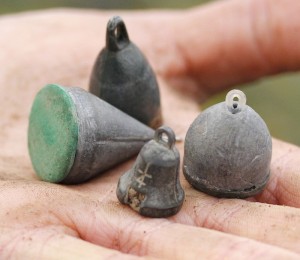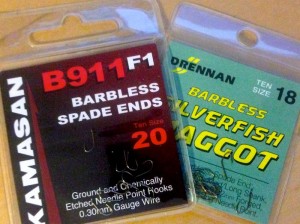Alan Scotthorne looks back at a recent match and explains a catch-everything approach that can turn an average peg into a money winner!
I have had some of the best mixed fishing in the last month than I can ever remember. That’s probably down to our mild winter and the fact that Garbolino Lindholme Lakes is now stuffed full of good-sized silver fish. Winning a match is difficult with this target-everything approach, but if you draw an average peg these extra silvers can lift your catch to a framing position if you attack it in the right manner.
On one match I drew Peg 76 on the now famous Bonsai Lake. This had been a poor area for carp and F1s but I adopted my silver fish approach to help me catch 81lb. About 40lb of that was silvers, including roach, skimmers and eight small tench that may have gone 10lb between them. I finished second overall with John Allerton winning with 85lb on the Method feeder. I was also on the golded peg that day, so John put paid to that pocket liner – much to fishery owner Neil Grantham’s amusement. cheers John!
This approach really does make for a lovely day’s fishing. Being really active is the key and this is a great way to fish as you are building your weight constantly. With odd F1s also making an appearance on this short caster line, a bigger weight is always on the cards, as it warms up and these fish become more active. Let’s look at my approach to making this a framing or match winning option.
The Approach
I would never look to just catch silvers, as the weights are too big at Lindholme, so I will always start for carp and Fls on either a long-pole line on island pegs or a feeder or straight lead line on the wider pegs where you cannot reach the far bank with a pole.
Peg 76 was a swim I could reach with the pole, so I started to the island with pellets and caught 11 F1s in the first hour and a half – before the wheels fell off. It is always important to keep your eyes on the surrounding anglers and I knew that most of them were also struggling for bites. I therefore knew I could start fishing for silvers while keeping my eye on other people’s catch rates. Steve Ringer is brilliant at watching what’s going on like this and it’s something I am trying to improve and use to help me make decisions during the match.
I had around 15lb in the net to build on but during this period I had been throwing caster to a line at about five metres out and at an 11 o’clock angle to where I had also cupped in half a 250ml Drennan pot full of chopped to worms, just to kickstart the swim.
Plumbing Up

When I plumbed this area I was right on the edge of where the silt starts on the bottom, just out of the full depth. This is the ideal place to fish but plumbing up is important as it is sometimes much closer on other pegs. The way to determine this is to drop the plummet quickly and then lift slowly and watch the elastic to see if the plummet is stuck in the silt. If you can lift the plummet cleanly you are on the hard bottom and this is the best place to fish.
Incidentally, as temperature’s lift, substituting the chopped worms for luncheon meat or corn can work better, but I always want a holding bait for these bigger fish when feeding casters, as extra bonus fish can make all the difference at the end of the match.
Once I start fishing this line I still want to feed the longer lines periodically in case I want to return to them if all starts going wrong. On this occasion, with the wind off my back I could ping a few 4mm pellets across with a catapult, just to help to keep these lines going.
Two Rigs

I always set up two rigs for this line: a 0.1g Drennan AS3 float for shallow and a 0.2g AS3 for on the bottom. With a depth of just 4ft, a 0.2g float is perfect for on the deck and I would only go bigger if the wind was bad or if it was deeper, like it is on some pegs. Shotting is simple, with strung-out No12s on the lighter 0.1g float and a small bulk of four No10s on the 0.2g float plus two No10 dropper shots bellow the bulk. These floats have a slim body and a hollow plastic bristle with a carbon stem and really do work brilliantly for caster fishing. The buoyant top helps you to ignore the small indications and just striking at the proper bites results in more fish in the net.

Both rigs are on 0.15mm Drennan Supplex main line. I have being fishing very light recently with just a size 20 Kamasan B911 F1 hook to a 15cm hooklength of 0.93mm Supplex. This line is very supple and good for fishing on the drop but capable of landing bonus fish. Using No6 Preston Slip elastic through two full sections of my Acolyte pole to a Drennan Pull Bung to aid landing the bigger fish completes my setup. I will probably change to a Drennan Silverfish Maggot hook to a 0.117mm hooklength as it warms up and the fish start to wake up in the warmer water.
The Key

Feeding is without doubt the key to catching well on this line and I have tried all sorts of different ways of feeding the casters into the swim. On this match it was best to just throw casters when I had hooked a fish and with 30lb of roach in my catch you can see how I got through three pints of shells! Throwing bait on my float resulted in too many line bites off shallow fish, so feeding when the float was out of the swim was miles better.
Since this match I have tried this again but found it better to throw about 30 casters and fish for two or three fish before feeding again. The moral of this is to experiment with bait but keep bait going in, as there is no shortage of fish to keep in the swim.
When I felt I had a spell with no bigger fish I also introduced a small amount of chopped worm to try to draw odd bonus fish into the area. It became apparent that each time I caught a tench or F1 it would be during a quiet spell of catching roach, so be patient when sport slows as often a bigger fish is present.
On this match I never went back across as I was catching so well close in that I knew I was on for a good weight. I also managed another eight F1s to add to the 11 I caught across. These samples were much bigger on the caster line as this is probably were they feel safer as we are all getting drawn to fish across in the colder weather. Food for thought?
So, next time you draw a not so fancied peg, try this approach, as 40lb of silvers and 41lb of F1s is a great day’s fishing in my book!

